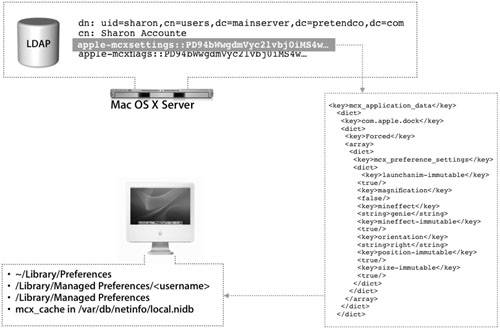Understanding Similar LDAP Attributes
| Although some LDAP attributes seem similar to Open Directory attributes, their uses are very different. The following definitions refer to a default configuration of the LDAPv3 plug-in on Mac OS X and a default configuration of the LDAP directory on Mac OS X Server:
For user accounts, there are two available attributes for home folders in LDAP:
It is critical that these attribute differences be understood. It's just human nature to see what we want to see, and mistakenly assume that UID stands for a user's ID value rather than the short name for a user account. Networked User AttributesLDAP and Open Directory make it possible to use network user accounts to store and administer account information in a remote data store, thus removing the need to handle many local accounts. Network user accounts offer the following benefits:
In addition to the standard attributes for user accounts, network user accounts make use of the following attributes:
Managed Client AttributesThe configurations for managed client and mobile account options are stored in the LDAP directory using the apple-mcxsettings and apple-mcxflags attributes. Each user, group, or computer account that has managed preferences enforced would have a base-64 value assigned to those attributes in the entry. The information is stored as encoded XML code that will be interpreted by the client computer when it binds to the LDAP server. The results are placed on the client based on the type of settings. Depending on the number of preferences managed, the mcxsettings value can be quite large. While this is not a problem, it does permit the administrator to paste the value into any text editor and manually edit any values he or she wants, then paste the string back into the value field.  The managed preferences, when passed down to Mac OS X, can reside in several places:
Managed group preferences are applied when the login window appears, and managed computer and mount settings are applied when the computer boots. The data is also stored in mcx_cache in the local NetInfo database (/var/db/netinfo/ local.nidb) for offline use. This information can be removed from the database using NetInfo Manager or Workgroup Manager running locally. |
EAN: 2147483647
Pages: 258
- Chapter I e-Search: A Conceptual Framework of Online Consumer Behavior
- Chapter II Information Search on the Internet: A Causal Model
- Chapter III Two Models of Online Patronage: Why Do Consumers Shop on the Internet?
- Chapter V Consumer Complaint Behavior in the Online Environment
- Chapter XII Web Design and E-Commerce